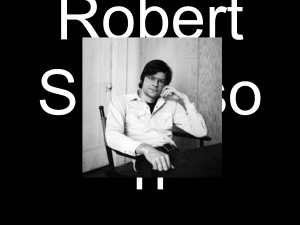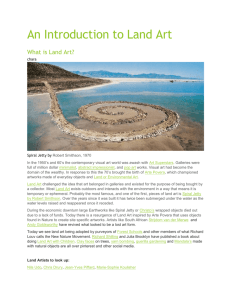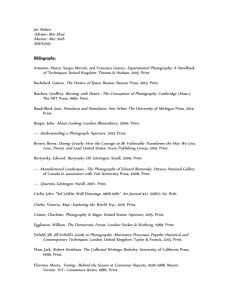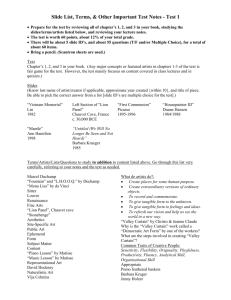Robert Smithson and the Anglo-American Picturesque
advertisement
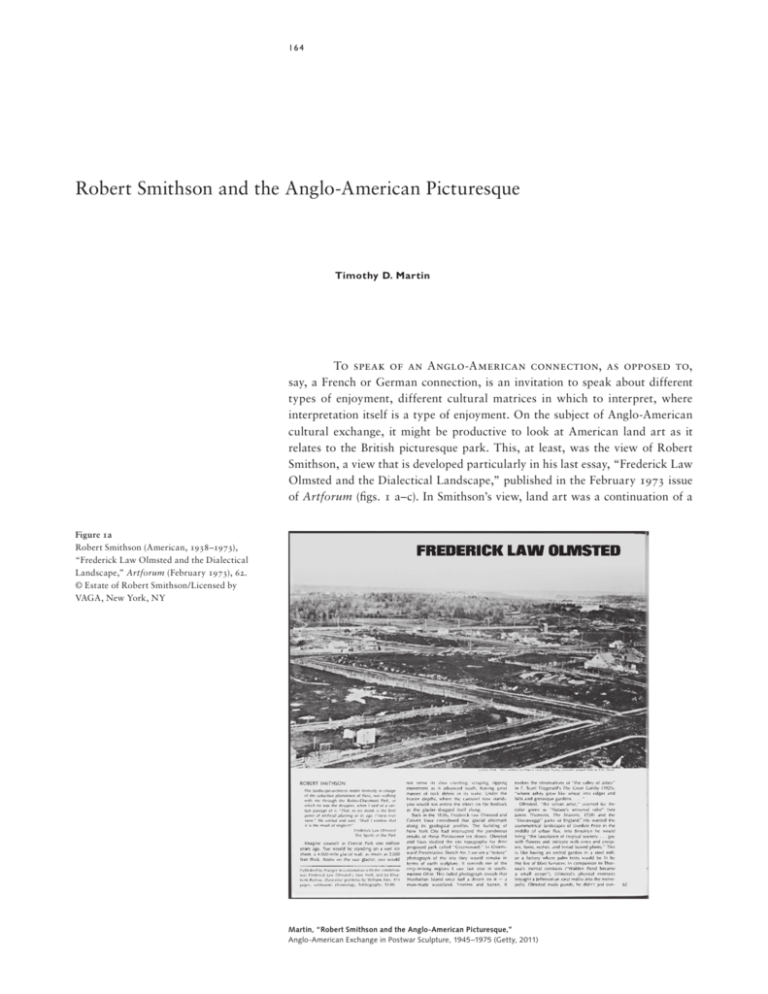
1 6 4 Robert Smithson and the Anglo-American Picturesque Timothy D. Martin To speak of an Anglo-American connection, as opposed to, say, a French or German connection, is an invitation to speak about different types of enjoyment, different cultural matrices in which to interpret, where interpretation itself is a type of enjoyment. On the subject of Anglo-American cultural exchange, it might be productive to look at American land art as it relates to the British picturesque park. This, at least, was the view of Robert Smithson, a view that is developed particularly in his last essay, “Frederick Law Olmsted and the Dialectical Landscape,” published in the February 1973 issue of Artforum (figs. 1 a–c). In Smithson’s view, land art was a continuation of a Figure 1a Robert Smithson (American, 1938–1973), “Frederick Law Olmsted and the Dialectical Landscape,” Artforum (February 1973), 62. © Estate of Robert Smithson/Licensed by VAGA, New York, NY Martin, “Robert Smithson and the Anglo-American Picturesque,” Anglo-American Exchange in Postwar Sculpture, 1945–1975 (Getty, 2011) 1 6 5 Robert Smit hson a nd t he A nglo-A merica n Pict ur esque Figure 1b Robert Smithson (American, 1938–1973), “Frederick Law Olmsted and the Dialectical Landscape,” Artforum (February 1973), 63. © Estate of Robert Smithson/Licensed by VAGA, New York, NY Figure 1c Robert Smithson (American, 1938–1973), “Frederick Law Olmsted and the Dialectical Landscape,” Artforum (February 1973), 65. © Estate of Robert Smithson/Licensed by VAGA, New York, NY Martin, “Robert Smithson and the Anglo-American Picturesque,” Anglo-American Exchange in Postwar Sculpture, 1945–1975 (Getty, 2011) 1 6 6 Timot h y D. M a rtin discourse that dated back at least to the British garden movements of the seventeenth and eighteenth centuries—a discourse that used the garden to create and test a new philosophy based on natural law rather than on religious law. Through his study of art history, phenomenology, anthropology, and psychoanalysis Smithson outlined a new status for land art. He suggested a philosophy, a ­political strategy, and a new role for the artist—that of analyst who understands and can act to resolve social conflict. If one aim of the Olmsted essay was to show how the artists of the Anglo-American picturesque were negotiators between conflicted members of a democratic society, then a further aim was to show how contemporary land artists might similarly mediate between capitalist mining companies and ecology movements. To set out some of the wider context, “Frederick Law Olmsted” is an unusual essay for Smithson. It is scholarly, but without his deadpan dramatics of extreme materialism, and most unusually he openly seeks to combine artistic and democratic political values. And where this essay is glowingly positive about Olmsted—who designed Central Park in New York in the 1850s—it is worth mentioning that Smithson was, at the same time, also willing to criticize Marcel Duchamp and Clement Greenberg, whom he claimed were dangerously antidemocratic and idealist.1 Having completed Spiral Jetty in 1970 Smithson was, by 1973, a key figure in the land art movement, and in some respects his Olmsted essay was intended to be an ex post facto manifesto. One could be a bit naive and say that Smithson was legitimizing land art with a historical and European pedigree, but only by ignoring that the essay clearly serves a socially, politically, and economically engaged art—that, in other words, the essay is as concerned with how a legacy is used as it is with establishing the legacy in the first place. Politics was nothing new in the pages of Artforum, especially since the political heat of the summer of 1968, but during that summer Smithson remained silent on political issues, preferring instead to visit distant, uninhabited areas for his Non-Site sculptures and for Spiral Jetty (fig. 2). He held the view that an artist must first prove to be an adequate philosopher, must wander the furthest reaches of conFigure 2 Robert Smithson (American, 1938–1973), Spiral Jetty, 1970. Mud, salt crystals, rocks, water, 457.2 × 4.6 m (1500 × 15 ft.). New York, DIA Center for the Arts. © Estate of Robert Smithson/Licensed by VAGA, New York, NY. Photo: Gianfranco Gorgoni, courtesy of James Cohan Gallery, New York Martin, “Robert Smithson and the Anglo-American Picturesque,” Anglo-American Exchange in Postwar Sculpture, 1945–1975 (Getty, 2011) 1 6 7 Robert Smit hson a nd t he A nglo-A merica n Pict ur esque sciousness, before knowing how to convert artistic judgment into political action. By 1973 he was ready to take a political turn, using the park at the very center of New York as a model of a politically engaged artistic practice. As it turned out, the surprise of Smithson turning political was exceeded some months later by the shock of his death in a plane crash. Having briefly placed the Olmsted essay in the context of Smithson’s writings, let me turn now to an examination of the essay itself and its reasons for placing land art in the context of eighteenth-century British and French discourses on the garden. First, Smithson wanted to advocate a greater temporal consciousness as a key part of the new land art movement; going back in history nicely served this end by providing the movement with antecedents. But he also wanted to remind his readers that the historical argument over the picturesque was as much about politics as it was about aesthetics. The British picturesque garden worked with real material places and with the causal laws of nature, and with them made a place where real social parties could meet to negotiate and resolve their conflicts. Where the British used the picturesque garden to naturalize parliamentary democracy and posit political debate and negotiation as analogues of natural law, the French used the formal garden to represent the hierarchical political structure of absolute monarchy as an analogue of religious law. Smithson sees here two modes of enjoyment according to a preference for either domination or cooperation. In the French garden, an ideal is imposed on nature, whereas in the British garden a design is worked out with nature. As Smithson hinted in psychoanalytic terms, the French aristocratic preference for domination indicated an underlying sadistic enjoyment that had no place in democratic politics. 2 Smithson traces a different mode of enjoyment stemming from the British picturesque, starting with the common root of Immanuel Kant and Edmund Burke. Kant’s Critique of Pure Reason established a dialectical aesthetic for the appreciation of nature as a thing in itself. There was the beautiful, whose temporality was instantaneous, and its opposite, the sublime, whose temporality was infinite. Burke proposed that there was also a middle ground between them, the picturesque, that was capable of multiple temporal consciousnesses. The park lay at the center of British eighteenth-century civilization because it provided a place of multiple temporalities in which citizens could work out both the short-term beauties and the long-term sublime goals of a parliamentary society. The park was a real material place where conflicting ideals could appear only to the degree that they could be physically worked out with the materials of the land and the laws of nature. Thus it was only to the degree that an idea could be materialized that it could enter the picturesque garden where, according to democratic principles, it could be altered, tested, interpreted, debated, and assessed, evolving as it did a basis for social relations. Smithson was deeply sympathetic to this kind of enjoyment. He traveled to England in 1969 to visit these gardens and made a study of the work of Price and Gilpin in Britain and the extension of their ideas to Olmsted in America. What these artists of the picturesque did was to emphasize brief temporal experiences of beauty alongside a consciousness of vast time scales produced by historical allusions and the geology of the landscape itself. And they did so in order to provide the right kinds of experiences and places for democratic communal life to transpire. Martin, “Robert Smithson and the Anglo-American Picturesque,” Anglo-American Exchange in Postwar Sculpture, 1945–1975 (Getty, 2011) 1 6 8 Timot h y D. M a rtin How, for Smithson, did the American picturesque in the nineteenth century continue on from its British counterpart in the eighteenth century? Politically, Olmsted was more democratic than the latter. An active antislavery author in his youth, Olmsted wanted to establish a fully egalitarian park, one in which all citizens, regardless of class and race, could gather. Olmsted’s park was a place of negotiation rather than domination and was intended to relieve the notable conflicts of his day, particularly evident in the contemporary American Civil War. Smithson also sees a philosophical shift, explaining it through the famous nineteenth-century mind-matter debate with its contending philosophies of idealism and materialism. Idealism flourished in British romanticism and American transcendentalism (Henry David Thoreau, for example), allowing both to regard mental life as separate from physical life, and leading both to propose garden utopias that banned industrialization and the machine. Against the idealists with their garden fantasies of a lost paradise, where man lives in absolute harmony with nature, Smithson positions Olmsted as the great alternative. Working in New York at a time of vast military-industrial expansion, Olmsted used machines, avoided romantic idealizations of nature, and resisted requests that he build a utopia. Olmsted is praised as an Anglo-American materialist (his partner in his design practice was the Englishman Calvert Vaux) who did not abandon the physical work of democratic politics and gardening, or his commitment to real material solutions to the antagonisms of both nature and society. In the American picturesque, industrialization was not a man-made evil that threatened an idyllic paradise; it could be a vehicle of the common good, it was just another fact on the ground to be integrated into the dialectical antagonisms played out in the park. The American picturesque, as carried out by Olmsted, was less influenced by Romantic idealism than was the British picturesque; it was less interested in denying the man-made in favor of the natural, and more concerned with integrating the two. For Smithson the picturesque was the historical antecedent of land art (both were politically democratic and philosophically materialist), and like its predecessor land art would use different temporal modes to produce glimpses of a shared communal material existence. Likewise, land art would also benefit from the machine and would have to contend with a contemporary modernist romantic idealism. Smithson’s history of the picturesque, limited and partial as it is, provides Smithson a political and philosophical framework with which to differentiate land art from other contemporary art movements. In his terms, modernism was a largely romantic idealistic movement—one that viewed abstract art as an escape from the natural world into a purely mental domain. For Smithson everything is material; his abstract sculptures illustrate the geometry and principles of geological crystals. Contrary to modernism, dialectics are not mental or ideational; they are physical events. Postmodern land art was materialist; it worked with matter not ideas, and it did not claim to make meaning either, but only to make good signifiers as if taken out of the earth. On its own, Smithson’s materialism is a bit extreme but not very remarkable. What made it interesting was the way he combined it with theories of mind taken from phenomenology, anthropology, and psychoanalysis. I would like to look at each of these theories in turn before showing how they were combined in his late land reclamation proposals. Smithson worked with phenomenological practices through the late 1960s by attending to the ways in which, during site visits, raw sense data was Martin, “Robert Smithson and the Anglo-American Picturesque,” Anglo-American Exchange in Postwar Sculpture, 1945–1975 (Getty, 2011) 1 6 9 Robert Smit hson a nd t he A nglo-A merica n Pict ur esque transformed and organized so that it could become a mental construct. Smithson, like so many phenomenologists, proposed that the way in which sense data from a site was organized by the mind was determined partly by the way the site itself was organized. Smithson makes use of Heidegger’s phenomenological concept of the groundedness of consciousness, in which the structures of the landscape suggest analogous mental structures by which to understand the landscape. Phenomenological practices such as his Site/Non-Site works did not lead to a better knowledge of the distinction between mind and matter, subject and object, but rather to an understanding of the lack of distinction between them. At this point in the process of making Site/Non-Site works, he encounters his “being-in-the-world,” as Heidegger put it. And this sense of “being” was an instance of matter’s awareness of itself as matter. Smithson used Heidegger to formulate a conception of democratic participation at a time when such use was not unusual. In the 1960s JeanPaul Sartre, for example, also used Heidegger, but the outcome was quite different. Sartre valued democratic action, as it was only by acting in the world that real being could be acquired. For Smithson democratic participation was closer to a cooperation in a shared concrete vision—shared because everyone was ultimately a being-in-the-world. Though the framework of the subject-object haunts him, it disintegrates; it is matter alone that is conscious, matter that thinks, and when the mind becomes conscious of itself as matter, it is an important fundamental experience necessary (or at least highly advantageous) to democratic moral and political judgment. So, if there is a political value to be found in phenomenology, for Smithson it lay with its ability to induce a sublime experience of total materiality. Mind is matter, and the politically active democratic artist ought to produce an awe in the face of matter becoming conscious, because it is in this state, where there is no clear subject, that we are best able to apprehend the common “natural rights” of all citizens. For Smithson, Olmsted’s Central Park was a product of Olmsted’s phenomenological intervention on a site. He took the center of mid-Manhattan Island, an acidic patch of barren land, and dramatized its geology of glacial deposits and melt pools. He encountered and cooperated with the material ideas on the site by emphasizing the language of the site itself, its sedimentation, deposition, and erosion, as if he were an agent of nature; it was an active, material being-in-the-world. Smithson wanted to take this phenomenological method a little further, and in a series of Site/Non-Site sculptures he experimented with ways to slip into an undifferentiated state, where the differences between the site and his sight would relax until they were materially the same thing. He would then allow the structures of the material of the site to begin to structure his sense experience of sight. In this way he would begin to think like the site. These journeys to the peripheries of mind and matter did not spin off to infinity, but rather encountered impassable limits, and it was on these limits that Smithson sought to base a political morality. Shared rights were not derived “from on high” (the idealist principle of freedom), but were grounded from the bottom up, where people are agents among the laws of matter. It was after these site experiments that he made his first real park, the earthwork called Spiral Jetty. Spiral Jetty was the first major attempt to construct a park that would help induce this state, through a paced-out experience of a collapse between subject and object consciousness. Although Spiral Jetty is a phenomenologically informed work, it is also a personal and visionary work, and was still part of Martin, “Robert Smithson and the Anglo-American Picturesque,” Anglo-American Exchange in Postwar Sculpture, 1945–1975 (Getty, 2011) 1 7 0 Timot h y D. M a rtin his prepolitical oeuvre. In the several years after Spiral Jetty, in the Olmsted essay, he is using psychoanalysis as a point of reflection. He seems to have concluded that his more visionary journeys into undifferentiation could cross the line into hallucination, and that this was surprisingly valuable to both art and politics. His reading of psychoanalytic texts (mostly by Carl Jung and Anton Ehrenzweig) on visionary art had allowed him a kind of hallucinatory skill that enabled him to synthesize and bond his conflicting fantasies. But the political role of the artist demanded more than this; the artist had to be a kind of communal shaman capable of what he called infra criticism—a “descending” of one’s own personal conflicts, as well as those of the democratic society in which he lives. Land art was an art that came from and was addressed to a collective primordial consciousness, and it was through this consciousness that the artist would understand and resolve social conflict. Smithson’s political turn, then, was surprising and different. He did not, for example, march for equal rights or to end the Vietnam War; he didn’t ally himself to the growing ecology movement of the day. Rather than resist industrialization he wanted the land artist to use heavy technology well, and to only intervene after making phenomenological, anthropological, and psychoanalytic analyses of the types of consciousnesses involved in social and political conflict. Only after this could an appropriate artistic intervention be conceived, and this conception occurred best after a state of psychic undifferentiation. The solution produced by this process could have a delusional as if quality that was remarkably like certain shamanistic visions. Smithson’s conception of the social role of the shaman came from anthropology, and it would be helpful to quickly mention how he used the work of the British structural anthropologist Mary Douglas. Smithson’s proposals for “a concrete dialectic between nature and people,” land and man, 3 were thought through with help from another important source, Mary Douglas and her book Purity and Danger.4 Using this book as a point of departure, he formulated a model for artistic practice in the social sphere that invoked both phenomenology and structuralism. On the one hand, as per phenomenology, the artist needed to be aware of how fundamental cognitive structures are taken from the material environment. On the other hand, as per structuralism, the artist also needed to be aware of how the mind takes its structures for thinking from the cultural environment. To this end Smithson was a keen reader of the work of Roland Barthes and Claude Lévi-Strauss. 5 For example, Lévi-Strauss described Anglo-American civilization as a “hot” culture that consumed large amounts of energy and materials, because it privileged synchronic rather than diachronic temporal consciousness, giving preference to the hot enjoyments of the here and now, over and above the cool enjoyments of a diachronic cosmological time frame. With two distinct modes of consciousness to deal with, the artist needed to create a new landscape, to envision new structures—and not just any structures, but those that are, according to Mary Douglas, good for interacting with other people and making an understanding of communal action. For Smithson land art served the long-term goals of a democracy by revealing its endeavors in the light of the laws of time and matter, rather than the romantic idealizations of freedom or the satisfaction of consumer demand. In effect Smithson was using anthropology and psychoanalysis to make a diagnosis of his culture. The preference for hot-energy–consuming enjoyment had to be pitted against a very different kind of material desire, namely man’s slower, calmer erotic bond with the material world. Martin, “Robert Smithson and the Anglo-American Picturesque,” Anglo-American Exchange in Postwar Sculpture, 1945–1975 (Getty, 2011) 1 7 1 Robert Smit hson a nd t he A nglo-A merica n Pict ur esque Smithson used structuralist anthropology to help define the social role of the artist shaman, and he used psychoanalysis to understand his own descent into the void of mind and matter and the hallucinatory phenomena he encountered there. But he also used psychoanalysis to diagnose the enjoyments of the parties involved in social conflict. As a negotiator between ecologist and industrialist he had to understand the types of enjoyment they sought, and to this end he made a fascinating distinction between the neurosis (hysteria) of the ecologist and the perversion (sadism) of the industrialist. This may be his most interesting contribution to Anglo-American cultural exchange and deserves a little more detail. In an analysis that is spread out among several published and unpublished texts Smithson developed a fairly full diagnosis of a neurosis in the ecology movement and a perversion in capitalism. It is worth pausing over his arguments if we are to make sense of why Smithson saw himself as continuing an Anglo-American land-art tradition. Starting with the hysteria of the ecologists, he locates their position (as we have discussed above) in a lineage of AngloAmerican idealist thinking dating back to Thoreau’s transcendentalism in the nineteenth century. Thoreau only thought about his pond, when he would have been better off, like Olmsted, actually building one. Transcendentalism approaches nature through ideas and tends to project human characteristics onto nature, resulting in a humanist anthropomorphism. As such, Smithson posited that anthropomorphism was an erroneous form of self-projection and usually announced additional, more serious projections of repressed sexual fears. His point is most developed in the Olmsted essay, when he responds to critics of mining and land art who argued that both endeavors carried out militaristic and violent acts on the body of mother earth. Smithson’s response was to diagnose an “Ecological Oedipus Complex.”6 In Freudian logic, invoking a taboo is tantamount to indicating a repressed desire for the same. By citing a taboo against sex with one’s mother, these ecologists revealed their own repressed traumas. Like Oedipus, the ecologists can be full of hubris, announcing their intentions to persecute the perpetrators of mining and pollution, for example, only to discover that they are fully implicated in the crime. In material terms, their enjoyment of the benefits of mining incriminates them in the same act. Their easy morality is maintained because they refuse to think dialectically, refuse to see themselves as material objects in a greater material order of things. Thus, Smithson rejected idealism and anthropomorphism because they were not real encounters with nature as a split and conflicted substance; they promulgated foolish laws that ignored nature as something constituted out of its antagonisms. Similarly, Smithson regarded modernist sculpture parks as forms of fantasy defense, screens with which to hide the difficult truths of a material world that was ruled by the blind and subjectless drives of life and death as they span the vastness of time. Less developed is Smithson’s analysis of industrialists caught in a sadistic extraction of natural resources that perverted their bond with nature. According to Smithson, they subscribe to a form of shared denial: “I know very well but, nevertheless . . . all I see is the technological and economic aspect of what I do.” This denial of his own materiality creates for the industrialist a blindness to the visual landscape. “When the miner loses consciousness of what he is doing through the abstractions of technology he cannot cope with his own inherent nature or external nature.”7 Smithson starts with a phenomenological Martin, “Robert Smithson and the Anglo-American Picturesque,” Anglo-American Exchange in Postwar Sculpture, 1945–1975 (Getty, 2011) 1 7 2 Timot h y D. M a rtin analysis, noting the industrialist’s lack of ability to observe the world, to be in and part of the world, which is replaced by the abstractions of technology and economics. Industrialists are blind to the potential disasters of what they do because they are blind to the disasters of nature that produced the very minerals and fossils they excavate. Because they lack a primordial consciousness, an awareness of a fundamental being-in-the-world (as Martin Heidegger called it), Smithson suggested that industrialists enacted a kind of unconscious sadism, that in serving capitalism and its promises of enjoyment, they were blind to the ways they were first and foremost agents of nature involved in an erotic and deathly act of union with the world. If I might flesh out his argument here, like the Marquis de Sade, they acted as if they had the natural right to extract any enjoyment out of the body of their lover, regardless of the pain it might cause. But mining does not have to be sadistic. The miner, like the land artist, can love the earth, can ponder nature as a lover might ponder the beloved. As Smithson put it, “sex isn’t all a series of rapes.”8 In the early 1970s, Smithson was edging toward endorsing proposed environmental laws that would require a reclamation plan as part of a mining license; however, it was not his preferred route. Although such laws would grant the land artist a legal status, Smithson thought it would be better if the industrialist actively sought the artist’s interventions. Smithson’s proposals showed industrialists how to turn their mines into gardens, into sites of temporal consciousness. Engaging industrialists in the park would prompt them to actively show their affection for nature. And, of course, they also had the means to move the millions of tons of earth required for such a garden. Perhaps the most powerful example of Smithson’s later efforts to perpetuate the lineage of Anglo-American democratic gardens was his 1973 Bingham Copper Mining Pit—Utah, Reclamation Project (fig. 3). One could take the cynical view that the proposal was an embarrassing capitulation to big capitalism, that Smithson was browbeaten by his gallerist, a mining heiress. I think this would be to miss the integrity of the project, its tough amorality, even if it can only be imagined based on the single photographic study he lived to produce. This was Smithson’s last and perhaps most legendary vision of man in his contemporary conflict. The Bingham site was the largest man-made hole in the world, and the paradox of its reclamation was that it would require the demolition of an entire mountain to fill it in again. To this, Smithson proposed his own paradox made of jetties and lake, part Dantesque vision of infinite descent, but also an inverse glimpse of the sky—double vanishing point of infinite depth and height. Such a remote site would encourage the ecologist to actually go out into the devastated areas of nature to encounter his or her material existence. Experiencing the pleasure and pain of the material emptiness of nature might alter their consciousness and end their idealization of nature and themselves. Smithson’s gardens of time were sites where the ecologist and industrialist could come to terms with their conflict by seeing how they both shared in the dynamic conflictedness of nature in its inexorable descent into static entropy. The frozen whorl at the bottom of the pit recombined synchronic and diachronic temporal consciousness; it became a signifier-picture of our shared material reality, an “earthword” that, when the sun was at the right angle, returned man’s gaze of progress with the blind gaze of the void as such.9 For Smithson the integrity of the political artist lay in an ethics based on an under- Martin, “Robert Smithson and the Anglo-American Picturesque,” Anglo-American Exchange in Postwar Sculpture, 1945–1975 (Getty, 2011) 1 7 3 Robert Smit hson a nd t he A nglo-A merica n Pict ur esque Figure 3 Robert Smithson (American, 1938–1973), Bingham Copper Mining Pit—Utah, Reclamation Project, 1973. Photostat and plastic overlay with wax pencil, 47 × 34.3 cm (181 ⁄ 2 × 131 ⁄ 2 in.). New York, The Metropolitan Museum of Art, 2001.293. Gift of Pat and John Rosenwald. © Estate of Robert Smithson/ Licensed by VAGA, New York, NY. Photo © The Metropolitan Museum of Art/Art Resource, New York standing of and an acceptance of the laws of nature—above all, the law of entropy. This law was evident in one of the great themes of the picturesque ruin, the fall of great civilizations, and Smithson wanted this law to be made even more evident in the natural and built environment. But why should Smithson propose entropy as the primordial law of nature, and the basis of mediating the conflict between ecologists and industrialists? While he recognized that his visions of entropy owed something to his childhood circumstances, he still felt that it could be put to some good use. Democracy, Smithson argues, is the political form of entropy, wherein social conflict is worn down. Democracy is always a failure, always a struggle toward entropy, yet always open to a restructuring because of its orientation to a primordial consciousness. What he offers to a society of Anglo-American democratic tradition is a sense of its history and its enjoyments set out against a background of time itself. The Bingham pit would have been a very good place for environmentalists and industrialists to meet, to hear first from the artist, perhaps one of Smithson’s more memorable lines, “Deeper than the ruins of concentration camps, are worlds more frightening, worlds more meaningless. The hells of geology remain to be discovered. If art history is a nightmare, then what is natural history?”10 The task of the land artist is to create a garden—a place where democracy can look back upon itself, can catch sight of the material of the site in a way that Martin, “Robert Smithson and the Anglo-American Picturesque,” Anglo-American Exchange in Postwar Sculpture, 1945–1975 (Getty, 2011) 1 7 4 Timot h y D. M a rtin induces a sense of prenarrative, solid time. Things, in this garden, are markers of time, and even people are subject to entropy, to the disintegration of biological life downward into the earth upon which they gaze. From the edge of the deepest hole in the world one sees a territory where democracy is democracy precisely because it is the political philosophy that includes and enjoys its own material inconsistencies and paradoxes. For Smithson, then, land art contributed to an Anglo-American discourse that included Olmsted, Price, and Gilpin by constructing places that helped resolve the material crises of a democratic people. Notes 1 See “Robert Smithson on Duchamp: Interview with Moira Roth,” Artforum 12 (October 1973), in Robert Smithson: The Collected Writings, ed. Jack Flam (Berkeley, Los Angeles, and London: University of California Press, 1996), pp. 310–12. 2 Ibid. See also “A Sedimentation of the Mind: Earth Projects,” Artforum 7 (September 1968), in Robert Smithson: Collected Writings, p. 107. 3 Robert Smithson, “Frederick Law Olmsted and the Dialectical Landscape,” Artforum 11 (February 1973), in Robert Smithson: Collected Writings, p. 164. 4 Mary Douglas, Purity and Danger: An Analysis of Concepts of Pollution and Taboo (London: Routledge Keegan and Paul, 1966). 5 As far as can be determined, Smithson read Barthes’s On Racine (New York: Hill and Wang, 1964); “The Structuralist Activity,” Partisan Review, Winter 1964; “The Diseases of Costume,” Partisan Review, January 1967; Writing Degree Zero (New York: Hill and Wang, March 1968); and Elements of Semiology (New York: Hill and Wang, 1968). He discussed and misquoted Mythologies in 1967, though there was no published translation until 1972. He also owned a copy of Yale French Studies, October 1966. The topic of the issue was structuralism, and featured articles in translation by Lévi-Strauss and Jacques Lacan, as well as articles on the tradition of Anglo-American structuralism, Merleau-Ponty, anthropology, art, and literature. He also had, in Partisan Review, Leo Bersani’s, “From Bachelard to Barthes” (Spring 1967) and Peter Caws, “What Is Structuralism” (Winter 1968). David Paul Funt, “The Structuralist Debate,” Hudson Review, Winter 1969-70, gives concise accounts of Lévi-Strauss, Foucault, Barthes, Lacan, and Althusser. Lastly, in order of publication was The Structuralist Controversy (Baltimore: Johns Hopkins Press, 1972). 6 Smithson, “Frederick Law Olmsted and the Dialectical Landscape,” in Robert Smithson: Collected Writings, p. 163. 7 Robert Smithson, “Untitled” (1972), in Robert Smithson: Collected Writings, p. 379. 8 Smithson, “Frederick Law Olmsted and the Dialectical Landscape,” in Robert Smithson: Collected Writings, p. 164. 9 Craig Owens, “Earthwords,” October 10 (Autumn 1979), pp. 120–30. 10 Robert Smithson, “Art Through the Camera’s Eye,” (unpublished), in Robert Smithson: Collected Writings, p. 375. Martin, “Robert Smithson and the Anglo-American Picturesque,” Anglo-American Exchange in Postwar Sculpture, 1945–1975 (Getty, 2011)
